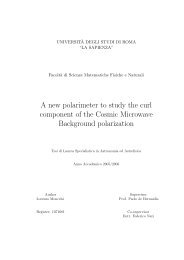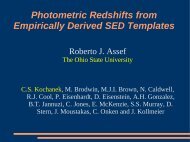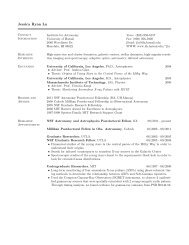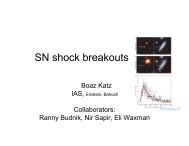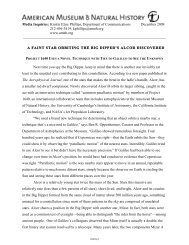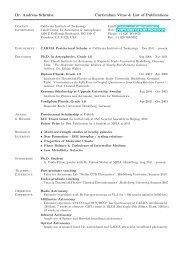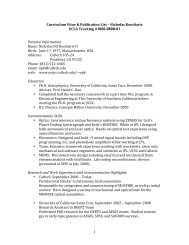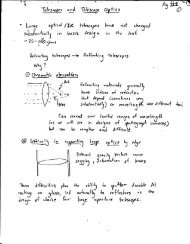Interferometric observations of pre-main sequence disks - Caltech ...
Interferometric observations of pre-main sequence disks - Caltech ...
Interferometric observations of pre-main sequence disks - Caltech ...
You also want an ePaper? Increase the reach of your titles
YUMPU automatically turns print PDFs into web optimized ePapers that Google loves.
1.3 Grain growth and planetary formation 15<br />
<strong>of</strong> varying opacity <strong>of</strong> the different transitions <strong>of</strong> CO and its isotopes, is possible to probe<br />
disk properties at different depth and calculate the relative CO abundance. For some<br />
nearby stars, the continuum <strong>observations</strong> show asymmetry in the radial dust distribu-<br />
tion which can be caused by dynamical perturbations <strong>of</strong> unknown companions or giant<br />
planets (Pietú et al., 2005; Corder et al., 2005). All these points will be discussed in<br />
more detail in Chapter 7 which describes new millimeter <strong>observations</strong> <strong>of</strong> the HAe star<br />
HD 163296.<br />
1.3 Grain growth and planetary formation<br />
Circumstellar <strong>disks</strong> around TTS and HAe are composed for about 99% <strong>of</strong> gas and for<br />
only 1% <strong>of</strong> solid dust grains. Nevertheless, as seen in the <strong>pre</strong>vious section, the dust<br />
component is responsible for the observed disk thermal emission, which re<strong>main</strong>s a key<br />
diagnostic tool to detect <strong>disks</strong> and characterize their structure. Dust grains dominate the<br />
disk opacity, control the disk temperature and geometry, regulate the chemical reactions<br />
<strong>of</strong> molecular species as CO and H2O in the colder parts <strong>of</strong> <strong>disks</strong>, and are the building<br />
block for the formation <strong>of</strong> planetesimals and planets within <strong>disks</strong>.<br />
From the diffuse interstellar medium to Class I objects, dust grains are, and re<strong>main</strong>,<br />
a mixture <strong>of</strong> amorphous silicates and carbons, with a size distribution from∼ 0.01µm<br />
to∼ 0.2µm (Draine et al., 2003; Bianchi et al., 2003; Kessler-Salacci et al., 2005). The<br />
situation changes drastically in circumstellar <strong>disks</strong> in which they grow many order <strong>of</strong><br />
magnitude in size forming kilometers-size body (planetesimals) and even planets.<br />
While the growth from sub-micron to micron sizes is probably driven by collisional<br />
aggregation in Brownian velocity fields (Blum, 2004), it is still under debate if the for-<br />
mation <strong>of</strong> meter size objects occurs through collisional aggregation (see the review <strong>of</strong><br />
Dominik et al., 2006) or gravitational instabilities in the over-dense dust regions <strong>of</strong> the<br />
disk (Youdin and Shu, 2002; Rice et al., 2004 and 2006). Modelling the grain growth<br />
requires a complex analysis <strong>of</strong> the dust and gas coupling, dust sticking properties and<br />
velocity fields within the disk. While growing in mass, particles start to decouple from



